Introduction
Japanese cuisine has transcended cultural and geographical boundaries to become a global phenomenon. The popularity of japanese food is evident in bustling sushi bars in New York, ramen shops in London, and conveyor belt eateries in Sydney. This widespread acclaim stems from a unique blend of tradition, innovation, and the universal appeal of fresh, flavorful ingredients. Whether it’s the delicate artistry of sushi, the comforting warmth of ramen, or the irresistible sweetness of mochi, Japanese food offers something for every palate.
The rise of Japanese cuisine can be attributed to several factors, including its health benefits, aesthetic presentation, and the ability to cater to diverse tastes. As more people seek out healthy and visually appealing meal options, Japanese food fits the bill perfectly. Additionally, the globalization of food culture and the influence of Japanese pop culture, such as anime and manga, have played significant roles in boosting its popularity.
For those interested in diving deeper into traditional Japanese desserts, explore our traditional-japanese-desserts-recipe for authentic sweet treats that capture the essence of Japan’s rich culinary heritage. Let’s embark on a journey to understand why Japanese food has garnered such immense popularity worldwide.
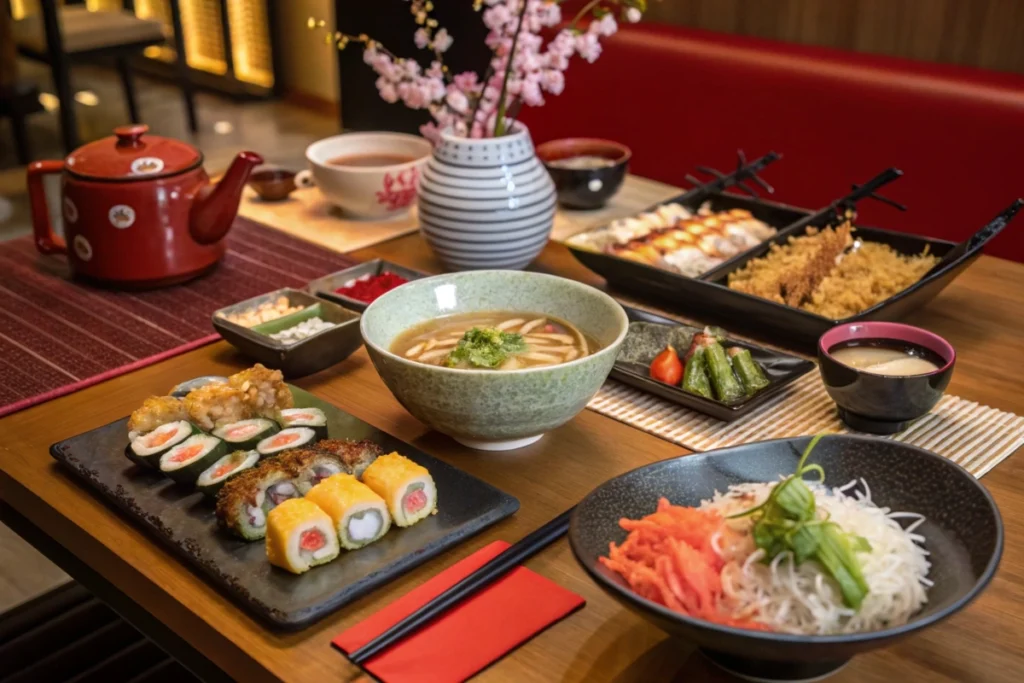
1. The Rise of Japanese Cuisine Globally
The popularity of japanese food has surged over the past few decades, making it one of the most beloved international cuisines. This rise can be attributed to several key factors:
Health Benefits and Fresh Ingredients
Japanese food is renowned for its emphasis on fresh, high-quality ingredients. Dishes like sushi and sashimi feature raw fish, which is rich in omega-3 fatty acids and essential nutrients. Additionally, the Japanese diet includes a variety of vegetables, tofu, and seaweed, contributing to its reputation as a healthy eating choice.
- Low in Calories: Many Japanese dishes are low in calories but high in nutritional value, making them ideal for those seeking a balanced diet.
- Balanced Meals: Traditional Japanese meals are well-balanced, incorporating proteins, carbohydrates, and fats in harmonious proportions.
- Fermented Foods: Items like miso and natto are not only flavorful but also beneficial for gut health due to their probiotic content.
Aesthetic Presentation
Japanese cuisine places a strong emphasis on the visual presentation of food. The meticulous arrangement and vibrant colors make each dish a work of art, enhancing the overall dining experience.
- Seasonal Themes: Dishes often reflect the seasons, using seasonal ingredients and decorations to create a visually appealing plate.
- Minimalism: The minimalist approach ensures that each component of the dish is highlighted without overwhelming the senses.
- Attention to Detail: From the placement of garnishes to the choice of dishware, every detail is thoughtfully considered to enhance the visual appeal.
Culinary Innovation and Fusion
Japanese chefs are known for their creativity and willingness to innovate, blending traditional techniques with modern flavors. This fusion has led to the creation of new dishes that cater to global tastes while maintaining their authentic roots.
- Fusion Dishes: Items like sushi burritos and ramen burgers showcase the versatility of Japanese cuisine, adapting traditional dishes to fit different cultural contexts.
- Adaptability: Japanese food can be easily adapted to various dietary preferences, including vegetarian, vegan, and gluten-free options.
- Modern Techniques: Incorporating modern cooking techniques has allowed Japanese cuisine to evolve and stay relevant in a fast-paced culinary landscape.
Cultural Influence and Pop Culture
The influence of Japanese pop culture, including anime, manga, and video games, has played a significant role in popularizing Japanese food. Characters often enjoy traditional meals, inspiring fans to try the dishes themselves.
- Anime and Manga: Popular series frequently feature characters eating sushi, ramen, and other traditional dishes, sparking interest among fans.
- Celebrity Chefs: Renowned chefs like Nobu Matsuhisa and Masaharu Morimoto have brought Japanese cuisine to the forefront of the culinary world.
- Media Exposure: Cooking shows, documentaries, and social media platforms have showcased the diversity and richness of Japanese food, reaching a global audience.
Economic Factors and Accessibility
The globalization of the food industry has made Japanese cuisine more accessible than ever before. With the proliferation of Japanese restaurants worldwide and the availability of Japanese ingredients in supermarkets, enjoying Japanese food has become convenient and affordable.
- Global Chains: International chains like Sushi Itto and Ichiban Boshi have established a presence in major cities around the world.
- Ingredient Availability: The availability of key Japanese ingredients such as soy sauce, miso, and seaweed has made it easier for home cooks to recreate authentic dishes.
- Affordability: Competitive pricing and a variety of dining options, from high-end restaurants to affordable conveyor belt sushi bars, cater to different budgets.
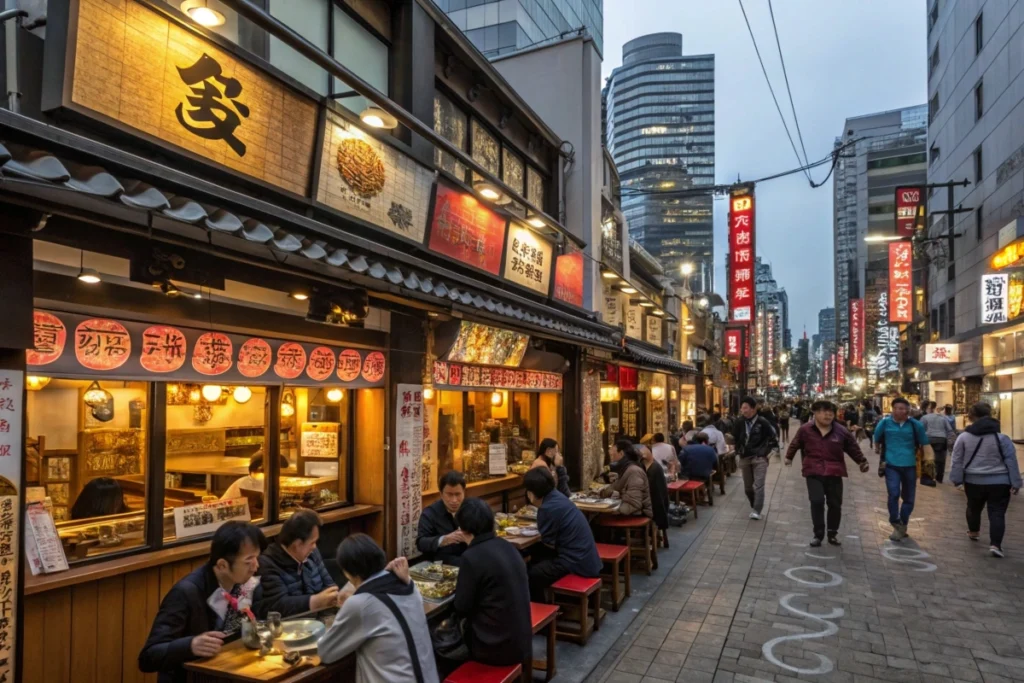
2. Iconic Japanese Dishes Driving Popularity
Several traditional and contemporary Japanese dishes have played pivotal roles in boosting the popularity of japanese food. These dishes are beloved not only in Japan but also across the globe, thanks to their unique flavors and cultural significance.
Sushi and Sashimi
Sushi and sashimi are perhaps the most recognizable Japanese dishes worldwide. Their simplicity and emphasis on fresh, high-quality ingredients make them universally appealing.
- Sushi: Consists of vinegared rice paired with various toppings, including raw fish, vegetables, and sometimes tropical fruits. Variations include nigiri, maki, and temaki.
- Sashimi: Pure slices of raw fish or seafood, often served with soy sauce, wasabi, and pickled ginger.
Ramen
Ramen has exploded in popularity outside Japan, with numerous variations catering to different tastes. This hearty noodle soup is beloved for its rich broth and customizable toppings.
- Broth Types: Common broths include tonkotsu (pork bone), shoyu (soy sauce), miso, and shio (salt).
- Noodles: Ramen noodles vary in thickness and texture, contributing to the dish’s versatility.
- Toppings: Typical toppings include chashu (braised pork), nori (seaweed), menma (bamboo shoots), and soft-boiled eggs.
Tempura
Tempura features seafood and vegetables that are lightly battered and deep-fried, resulting in a crispy texture without being greasy. It’s often served with a dipping sauce called tentsuyu.
- Seafood: Common tempura items include shrimp, squid, and white fish.
- Vegetables: Vegetables like sweet potatoes, bell peppers, and eggplant are popular choices.
Okonomiyaki
Often described as a savory pancake, okonomiyaki is a versatile dish that includes a variety of ingredients such as cabbage, meat, seafood, and cheese, all mixed into a batter and cooked on a griddle.
- Regional Variations: Kansai-style is known for its use of mayonnaise and a variety of toppings, while Hiroshima-style includes layers of noodles.
- Customization: The name “okonomiyaki” translates to “as you like it,” reflecting the dish’s customizable nature.
Kaiseki
Kaiseki is a traditional multi-course meal that emphasizes seasonal ingredients and meticulous presentation. It’s considered the pinnacle of Japanese haute cuisine.
- Course Structure: Typically includes appetizers, sashimi, a grilled dish, simmered dish, and a dessert.
- Aesthetic Presentation: Each course is a visual masterpiece, arranged to reflect the season and the natural beauty of the ingredients.
Bento Boxes
Bento boxes are single-portion take-out or home-packed meals that are aesthetically arranged to include a balance of carbohydrates, proteins, and vegetables.
- Variety: Common items include rice or noodles, fish or meat, pickled or cooked vegetables, and sometimes fruit.
- Convenience: Bento boxes are popular for their portability and balanced nutrition, making them a staple for busy individuals.
Takoyaki and Taiyaki
Street food staples, takoyaki and taiyaki are beloved for their portability and delicious flavors.
- Takoyaki: Ball-shaped snacks made from a wheat flour-based batter and cooked with minced or diced octopus, tempura scraps, pickled ginger, and green onion.
- Taiyaki: Fish-shaped cakes filled with sweet red bean paste, custard, chocolate, or other fillings.
Matcha and Japanese Sweets
Matcha (green tea powder) is not only a beverage but also a key ingredient in a variety of Japanese sweets and desserts, contributing to the popularity of japanese food through its unique flavor and health benefits.
- Matcha Sweets: Include items like matcha ice cream, mochi, and cakes.
- Health Benefits: Rich in antioxidants, matcha is celebrated for its potential health benefits, including boosting metabolism and enhancing mood.
Conclusion of Iconic Dishes
These iconic dishes have not only defined Japanese cuisine but have also played a crucial role in its global popularity. Their unique flavors, health benefits, and aesthetic presentations make them favorites among diverse populations. As Japanese food continues to evolve and adapt to global tastes, its popularity shows no signs of waning.
3. Cultural Significance and Traditions Behind Japanese Cuisine
Understanding the popularity of japanese food requires delving into the cultural significance and traditions that underpin it. Japanese cuisine is deeply intertwined with the country’s history, philosophy, and societal values, which collectively contribute to its enduring appeal.
Washoku: The Essence of Japanese Cuisine
Washoku refers to traditional Japanese food, recognized by UNESCO as an Intangible Cultural Heritage. It embodies the principles of balance, seasonality, and harmony, both in flavor and presentation.
- Seasonality (Shun): Emphasizes using ingredients at their peak season for optimal flavor and freshness.
- Balance: Ensures a harmonious distribution of flavors, colors, and textures across the meal.
- Presentation: Focuses on the aesthetic arrangement of food, reflecting the beauty of nature and simplicity.
Tea Ceremony and Its Influence
The Japanese tea ceremony, or chanoyu, is a ritualistic practice that highlights the importance of mindfulness, respect, and harmony in daily life. This ceremony has significantly influenced Japanese cuisine, emphasizing precision and aesthetics.
- Mindfulness: Every step, from preparing the tea to serving it, is performed with intentionality and grace.
- Aesthetics: The utensils, bowls, and environment are carefully selected to enhance the overall experience.
- Harmony: The ceremony fosters a sense of connection between the host, guests, and nature.
Regional Diversity in Japanese Cuisine
Japan’s diverse geography and climate have given rise to a wide variety of regional cuisines, each with its own unique flavors and specialties. This regional diversity contributes to the popularity of japanese food by offering a rich tapestry of culinary experiences.
- Kanto (Tokyo) Cuisine: Known for its sushi, tempura, and monjayaki.
- Kansai (Osaka, Kyoto) Cuisine: Famous for okonomiyaki, takoyaki, and kaiseki.
- Hokkaido Cuisine: Celebrated for its seafood, dairy products, and miso ramen.
- Kyushu Cuisine: Renowned for tonkotsu ramen, mentaiko (spicy cod roe), and motsunabe (offal hot pot).
Culinary Philosophy: Umami and Harmony
Japanese cuisine is celebrated for its mastery of umami, the fifth taste, which adds depth and richness to dishes. This culinary philosophy focuses on creating harmonious flavors that complement rather than overpower each other.
- Umami: Derived from ingredients like soy sauce, miso, seaweed, and bonito flakes, umami enhances the overall flavor profile of a dish.
- Harmony: Emphasizes the balance of sweet, salty, sour, bitter, and umami to create a well-rounded taste experience.
Respect for Ingredients and Sustainability
A core value in Japanese cuisine is the respectful use of ingredients, which aligns with broader cultural values of harmony with nature and sustainability.
- Minimal Waste: Japanese chefs are trained to use every part of an ingredient, minimizing waste and maximizing flavor.
- Sustainable Practices: Many traditional practices prioritize sustainable harvesting and responsible sourcing of ingredients.
Modern Influences and Global Integration
While deeply rooted in tradition, Japanese cuisine has also embraced modern influences and global integration, contributing to its widespread popularity.
- Fusion Cuisine: Combining Japanese techniques with flavors from other cultures has created innovative dishes that appeal to a global audience.
- Adaptability: Japanese food adapts to various dietary preferences, including vegetarian, vegan, and gluten-free options, making it accessible to a broader population.
- Technological Advancements: Innovations in cooking techniques and food preservation have allowed Japanese cuisine to maintain its high standards of quality and freshness.
Conclusion of Cultural Significance
The cultural significance and traditions behind Japanese cuisine are fundamental to understanding its popularity of japanese food. The harmonious blend of historical practices, regional diversity, culinary philosophy, and respect for ingredients has created a cuisine that is not only delicious but also deeply meaningful. This rich cultural foundation ensures that Japanese food continues to resonate with people around the world, fostering its enduring global appeal.

4. The Impact of Japanese Food on Global Cuisine
Japanese cuisine has significantly influenced global culinary trends, contributing to the popularity of japanese food through its unique flavors, techniques, and aesthetic presentations. This impact can be seen across various aspects of international cuisine, from restaurant menus to home cooking.
Sushi’s Global Domination
Sushi has become synonymous with Japanese cuisine worldwide, appearing in almost every major city. Its adaptability and variety have made it a favorite among diverse populations.
- Variety of Styles: From traditional nigiri and sashimi to modern fusion rolls like the California roll and spicy tuna roll, sushi offers something for everyone.
- Health Appeal: With its emphasis on fresh fish, vegetables, and minimal use of unhealthy fats, sushi is often perceived as a healthy dining option.
- Customization: The ability to customize sushi with different ingredients and flavors caters to a wide range of tastes and dietary preferences.
Ramen’s Comfort and Versatility
Ramen has experienced a renaissance outside Japan, with ramen shops opening in cities worldwide. Its comforting flavors and customizable nature have made it a staple in the global food scene.
- Broth Innovation: International chefs experiment with different broths and ingredients, creating unique versions that blend local flavors with traditional techniques.
- Cultural Integration: Ramen festivals, pop-up shops, and dedicated ramen bars have helped cement its place in global cuisine.
- Accessibility: Ramen’s affordability and hearty portions make it a popular choice for both casual diners and food enthusiasts.
Fusion and Adaptation in International Cuisines
Japanese culinary techniques and ingredients have been seamlessly integrated into various fusion cuisines, enhancing their complexity and appeal.
- Japanese-Italian Fusion: Dishes like sushi pizza and miso carbonara blend Japanese flavors with Italian staples.
- Japanese-Mexican Fusion: Burritos filled with teriyaki chicken or sushi-inspired tacos showcase the versatility of Japanese ingredients.
- Local Adaptations: In the United States, Japanese-style fried chicken (karaage) and Japanese burgers have become popular fast-food items.
Influence on Culinary Techniques and Presentation
Japanese culinary techniques, such as precise knife skills and artful plating, have influenced chefs globally, elevating the standard of food presentation.
- Knife Skills: The meticulous knife techniques used in Japanese cuisine have inspired chefs to adopt similar precision in their own cooking.
- Plating Art: The emphasis on aesthetic presentation has encouraged a focus on visual appeal in international restaurants, enhancing the dining experience.
- Ingredient Utilization: Various cuisines have adapted and incorporated techniques like tempura frying and sushi rolling, expanding their culinary repertoire.
Global Availability of Japanese Ingredients
The widespread availability of Japanese ingredients in supermarkets and specialty stores has made it easier for home cooks to experiment with Japanese recipes, further driving the popularity of japanese food.
- Ingredient Accessibility: Items like soy sauce, miso, nori, and wasabi are now readily available in most grocery stores, making Japanese cooking more accessible.
- Home Cooking Trends: The rise of cooking shows, online recipes, and food blogs has encouraged more people to try their hand at making Japanese dishes at home.
- Culinary Education: Cooking classes and workshops focused on Japanese cuisine have become popular, providing hands-on experience and knowledge to enthusiasts.
Economic and Social Factors
Economic and social factors also play a role in the popularity of japanese food. The global interest in diverse and exotic cuisines reflects a broader trend towards multiculturalism and culinary exploration.
- Economic Growth: Japan’s economic growth and cultural export have facilitated the spread of its cuisine worldwide.
- Social Media Influence: Platforms like Instagram and TikTok have amplified the visual appeal of Japanese food, making it a popular subject for food photography and viral trends.
- Health Consciousness: As more people prioritize healthy eating, the balanced and nutritious aspects of Japanese cuisine become increasingly attractive.
Conclusion of Global Impact
Japanese cuisine’s impact on global food culture is profound and multifaceted. Its ability to adapt, innovate, and maintain authenticity has ensured its popularity of japanese food continues to grow. From sushi and ramen to fusion dishes and culinary techniques, Japanese food has left an indelible mark on the world’s culinary landscape, fostering appreciation and enthusiasm across diverse populations.
5. Traditional Japanese Food vs. Modern Adaptations
The popularity of Japanese food stems not only from traditional dishes but also from adapting these classics to suit contemporary tastes and global preferences. This section explores the balance between preserving culinary heritage and embracing innovation.
Preservation of Traditional Recipes
Maintaining traditional recipes is crucial for preserving the cultural heritage of Japanese cuisine. Many chefs and home cooks alike strive to keep these age-old practices alive.
- Authentic Preparation: Emphasizing authentic methods and ingredients ensures that traditional flavors remain intact.
- Cultural Education: Cooking classes and culinary tours in Japan educate people about the origins and significance of traditional dishes.
- Family Traditions: Many Japanese families pass down recipes through generations, ensuring continuity and respect for culinary traditions.
Innovation and Fusion in Japanese Cuisine
While tradition is important, innovation plays a significant role in keeping Japanese cuisine relevant and exciting on the global stage.
- Fusion Dishes: Combining Japanese techniques with elements from other cuisines creates unique dishes that appeal to international palates.
- Modern Ingredients: Incorporating modern ingredients and superfoods into traditional recipes can enhance nutritional value and appeal.
- Creative Presentations: Innovative plating and presentation styles make Japanese dishes more visually appealing and shareable on social media platforms.
Influence of Western Cuisine
The influence of Western cuisine on Japanese food has led to the creation of beloved hybrid dishes that blend the best of both worlds.
- Katsu: Originally a Western-style cutlet, katsu has become a staple in Japanese cuisine, served with tonkatsu sauce and often paired with rice or noodles.
- Omurice: A Japanese adaptation of the Western omelet, omurice features fried rice wrapped in a thin omelet and topped with ketchup or demi-glace sauce.
- Curry Rice: Japanese curry, milder and sweeter than its Indian counterpart, has become a beloved comfort food, often served with rice, breaded pork cutlets, or vegetables.
Health-Conscious Adaptations
As global awareness of health and wellness grows, Japanese cuisine has adapted to meet these demands without compromising on flavor or tradition.
- Vegetarian and Vegan Options: Chefs can modify traditional dishes to exclude meat or animal products by incorporating tofu, vegetables, and plant-based broths.
- Low-Calorie Versions: Dishes like sushi and sashimi are naturally low in calories, appealing to health-conscious consumers.
- Nutrient-Dense Ingredients: Incorporating ingredients rich in vitamins, minerals, and antioxidants enhances the nutritional profile of Japanese dishes.
Technological Advancements in Cooking
Technology has also influenced the evolution of Japanese cuisine, enabling more precise and efficient cooking methods.
- Sous Vide Cooking: Precision temperature control allows for perfect texture and flavor retention in meats and fish.
- Automated Sushi Machines: These machines make sushi preparation faster and more consistent, increasing accessibility for restaurants and home cooks alike.
- Smart Kitchen Appliances: Modern kitchen gadgets, such as rice cookers with advanced settings, help replicate traditional cooking techniques with ease.
Global Adaptations and Regional Variations
Japanese cuisine adapts to regional tastes and ingredients, creating a diverse range of offerings that cater to local preferences.
- American Japanese Food: In the United States, dishes like the California roll and teriyaki chicken tailor themselves to suit Western tastes by incorporating more familiar ingredients and flavors.
- European Variations: European adaptations of Japanese dishes may emphasize more refined presentation and incorporate local culinary techniques.
- Localized Ingredients: Using locally sourced ingredients ensures that Japanese dishes remain fresh and relevant in different parts of the world.
Conclusion of Traditional vs. Modern
The popularity of Japanese food sustains itself by honoring traditional recipes while embracing innovation and adaptation. This balance allows Japanese cuisine to remain authentic and culturally significant, yet flexible and appealing to a global audience. As Japanese food continues to evolve, it will undoubtedly introduce new flavors and experiences that resonate with future generations.
6. History and Context of Japanese Food
To fully appreciate the popularity of japanese food, it’s essential to understand its historical roots and the cultural context that has shaped its evolution. Japanese cuisine is a reflection of the country’s geography, climate, and societal values, all of which have contributed to its distinctive culinary identity.
Early Influences and Foundations
Various factors such as climate, available resources, and interactions with neighboring countries have influenced Japanese food throughout its history.
- Agricultural Beginnings: Rice cultivation has been central to Japanese cuisine for centuries, serving as a staple food and a symbol of prosperity.
- Fishing and Seafood: Japan’s island geography ensures a plentiful supply of fresh seafood, which plays a crucial role in dishes like sushi, sashimi, and various seafood stews.
- Chinese and Korean Influences: Historical trade and cultural exchanges introduced soy sauce, tofu, and other ingredients, which have become integral to Japanese cooking.
Buddhism and Vegetarianism
The introduction of Buddhism to Japan in the 6th century had a profound impact on its cuisine, promoting vegetarianism and influencing cooking practices.
- Shojin Ryori: This Buddhist vegetarian cuisine emphasizes simplicity, seasonal ingredients, and balanced nutrition, laying the foundation for many traditional Japanese dishes.
- Preservation Techniques: Buddhism also influenced food preservation methods, such as pickling and fermenting, which are still prevalent in Japanese cuisine today.
The Edo Period and Culinary Innovation
The Edo period (1603-1868) was a time of peace and economic prosperity in Japan, leading to significant developments in culinary arts.
- Urbanization and Cuisine: The rise of cities like Edo (modern-day Tokyo) led to the proliferation of street food and specialized eateries, popularizing dishes like tempura, sushi, and soba.
- Sampuru: The creation of sampuru (food replicas) during this period catered to restaurant displays, allowing establishments to showcase their offerings without the risk of spoilage.
Meiji Restoration and Western Influences
The Meiji Restoration (1868) marked the beginning of Japan’s modernization and increased interaction with the West, which brought new culinary influences.
- Western Foods: Introduction of bread, beef, and dairy products led to the creation of Japanese adaptations like katsu (breaded cutlets) and omelet rice (omurice).
- Culinary Schools: Establishment of culinary schools that incorporated Western techniques, fostering innovation while preserving traditional practices.
Post-World War II and Globalization
Post-World War II Japan experienced rapid economic growth and increased global interaction, which further influenced its cuisine.
- Instant Ramen: Invented in 1958 by Momofuku Ando, instant ramen revolutionized convenience food and became a global staple.
- International Cuisine Exposure: Economic prosperity allowed more Japanese citizens to travel abroad and interact with different food cultures, leading to greater culinary diversity.
Modern-Day Japanese Cuisine
Today, Japanese cuisine is celebrated for its diversity, health benefits, and aesthetic appeal. It has continued to evolve, embracing both traditional and modern influences.
- Health and Wellness Trends: Emphasis on fresh ingredients and balanced meals aligns with global health consciousness.
- Culinary Tourism: Japan attracts millions of tourists annually, eager to experience authentic cuisine firsthand.
- Cultural Preservation: Efforts to preserve traditional recipes and cooking methods ensure that Japanese food remains true to its roots while adapting to contemporary tastes.
Conclusion of History and Context
The rich history and cultural context of Japanese cuisine have significantly contributed to its popularity of japanese food. From its agricultural beginnings and religious influences to periods of innovation and globalization, Japanese food has continually adapted and thrived. Understanding this historical backdrop enhances our appreciation for the intricate and diverse nature of Japanese cuisine, highlighting why it resonates so deeply on a global scale.
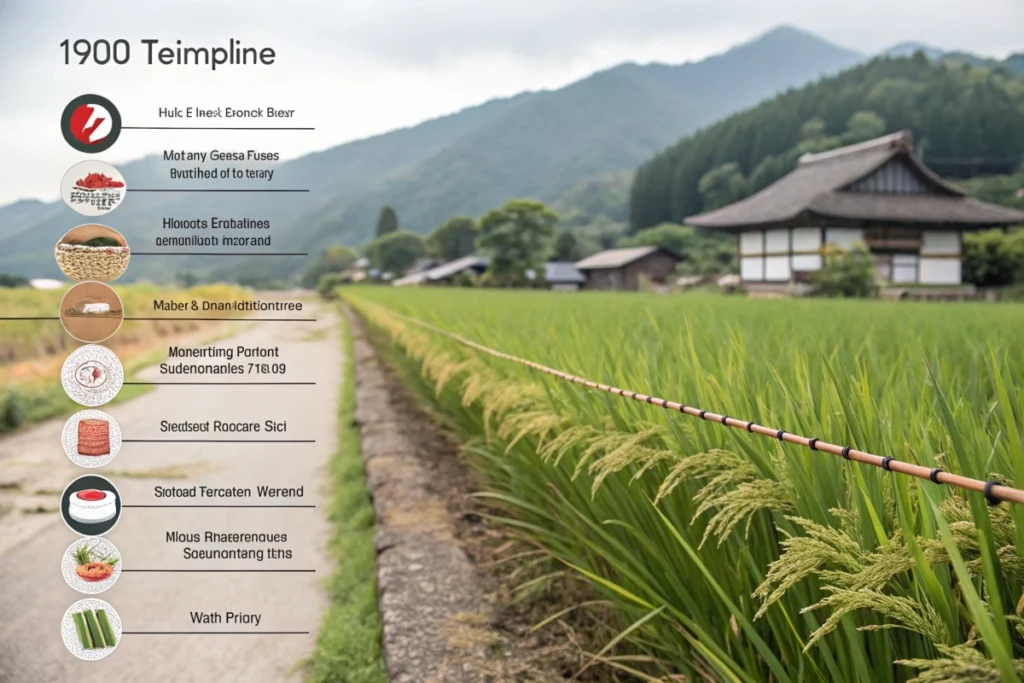
7. Practical Examples and Use Cases of Japanese Food Popularity
The popularity of japanese food is not just theoretical; it manifests in everyday scenarios and various industries around the world. Here are some practical examples and use cases that illustrate how Japanese cuisine has integrated into global culture.
Scenario 1: Curating a Japanese Dinner Party
Hosting a Japanese-themed dinner party is a fantastic way to showcase the popularity of japanese food. By selecting a variety of traditional and modern dishes, hosts can offer guests a comprehensive taste of Japanese cuisine.
- Appetizers: Start with miso soup and edamame to set the tone.
- Main Courses: Serve sushi rolls, tempura, and a hearty bowl of ramen.
- Desserts: Finish with mochi ice cream or dorayaki for a sweet touch.
- Beverages: Pair the meal with sake, green tea, or Japanese beer for an authentic experience.
This approach not only highlights the diversity of Japanese food but also allows guests to appreciate the cultural significance behind each dish.
Scenario 2: Japanese Restaurants Adapting to Local Tastes
Japanese restaurants around the world often adapt their menus to suit local preferences while maintaining authentic flavors, contributing to the popularity of japanese food.
- Fusion Dishes: Incorporate local ingredients into traditional recipes, such as adding avocado to sushi rolls or creating ramen with local vegetables.
- Menu Customization: Offer options that cater to dietary restrictions, including vegetarian and gluten-free dishes.
- Cultural Events: Host events like sushi-making workshops or sake tastings to engage customers and educate them about Japanese culture.
These adaptations make Japanese cuisine more accessible and appealing to a broader audience, fostering its global popularity.
Scenario 3: Home Cooking and Recipe Sharing
The rise of cooking shows, online tutorials, and food blogs has made Japanese recipes more accessible to home cooks, further enhancing the popularity of japanese food.
- Recipe Blogs: Websites like japanese-curry-recipe-one-piece offer detailed instructions for making authentic Japanese dishes at home.
- Cooking Classes: Virtual and in-person classes teach techniques like sushi rolling and tempura frying, empowering individuals to recreate Japanese flavors in their kitchens.
- Social Media: Platforms like Instagram and Pinterest showcase visually appealing Japanese recipes, inspiring users to try new dishes and share their creations.
This democratization of Japanese cuisine encourages more people to explore and enjoy its unique flavors and techniques.
Scenario 4: Japanese Food in Corporate Catering
Japanese cuisine has found its way into corporate catering services, offering healthy and diverse meal options that appeal to employees.
- Sushi Platters: Popular for meetings and events, sushi platters provide a sophisticated and customizable dining option.
- Ramen Bowls: Hot and hearty, ramen bowls are ideal for lunch meetings or casual gatherings.
- Bento Boxes: Convenient and balanced, bento boxes offer a variety of flavors and nutrients, catering to different tastes and dietary needs.
Incorporating Japanese dishes into corporate settings not only diversifies the menu but also promotes healthy eating habits among employees.
Scenario 5: Japanese Food Festivals and Events
Food festivals and cultural events celebrating Japanese cuisine play a significant role in promoting the popularity of japanese food.
- Ramen Festivals: Dedicated to showcasing different styles of ramen, these festivals attract food enthusiasts eager to sample a variety of broths and toppings.
- Sushi Competitions: Competitive sushi-making events highlight the skill and artistry involved in creating perfect sushi, inspiring both chefs and attendees.
- Street Food Markets: Featuring takoyaki, yakitori, and other Japanese street foods, these markets offer an authentic and interactive culinary experience.
These events create a sense of community and cultural appreciation, further embedding Japanese cuisine into the global food landscape.
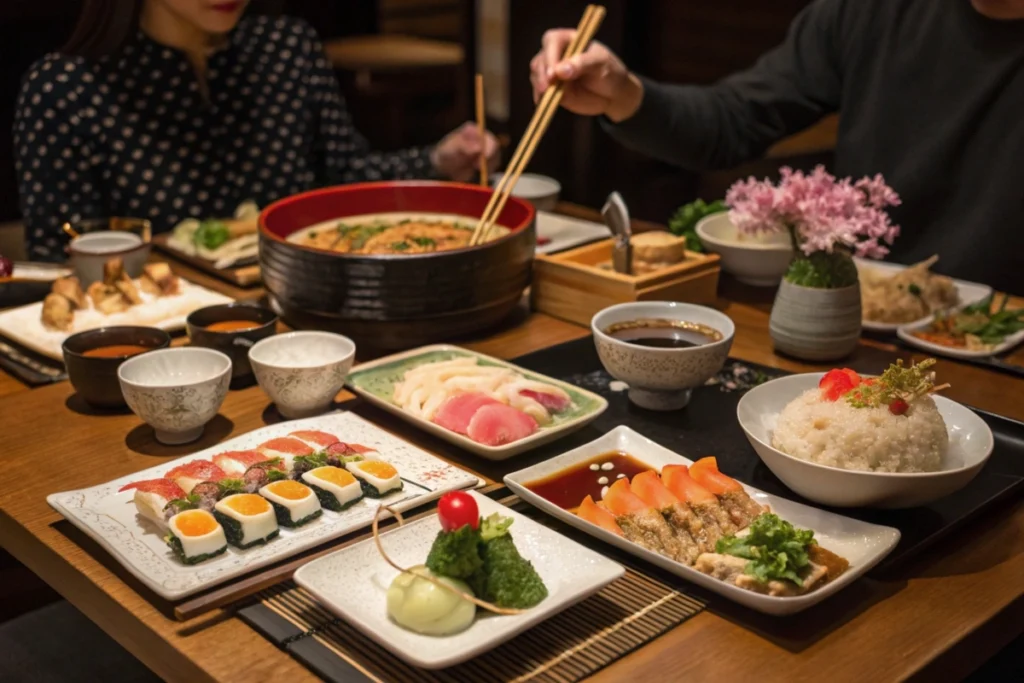
8.FAQs about popularity of japanese food
1. Why has Japanese food become so popular?
Japanese food has gained popularity because it emphasizes fresh, high-quality ingredients, aesthetic presentation, and health benefits. Additionally, the adaptability of Japanese cuisine to different dietary preferences and its integration into global pop culture have significantly contributed to its widespread appeal.
2. How popular is Japanese cuisine?
Japanese cuisine is highly popular worldwide, with sushi and ramen being staples in major cities across the globe. It ranks consistently high in global cuisine rankings due to its unique flavors, health benefits, and cultural significance. The global presence of Japanese restaurants and the availability of Japanese ingredients have further solidified its popularity.
3. What is the #1 most popular food in Japan?
Many people consider sushi the most popular food in Japan because of its variety, freshness, and cultural significance. They enjoy it in both casual settings like sushi bars and high-end restaurants, making it a versatile and beloved dish.
4. Where does Japanese food rank in the world?
Japanese food consistently ranks among the top international cuisines in global rankings. Its combination of flavor, health benefits, and aesthetic appeal make it a favorite among food enthusiasts and casual diners alike.
5. What are typical dishes in Japan that contribute to its popularity?
Typical dishes that contribute to the popularity of japanese food include sushi, sashimi, ramen, tempura, okonomiyaki, and kaiseki. These dishes showcase the diversity and depth of Japanese culinary traditions, appealing to a wide range of tastes.
6. How has Japanese food influenced other cuisines?
Japanese food has influenced other cuisines through fusion dishes, culinary techniques, and ingredient integration. For example, the creation of sushi burritos and ramen burgers exemplifies how Japanese culinary elements blend with Western favorites. These combinations create innovative and appealing new dishes.
7. Can Japanese food be found in regions outside Japan?
Yes, Japanese food is widely available in regions outside Japan, including North America, Europe, Asia, and Australia. The proliferation of sushi bars, ramen shops, and Japanese supermarkets showcases the globalization of Japanese cuisine. These establishments make it accessible to a global audience.
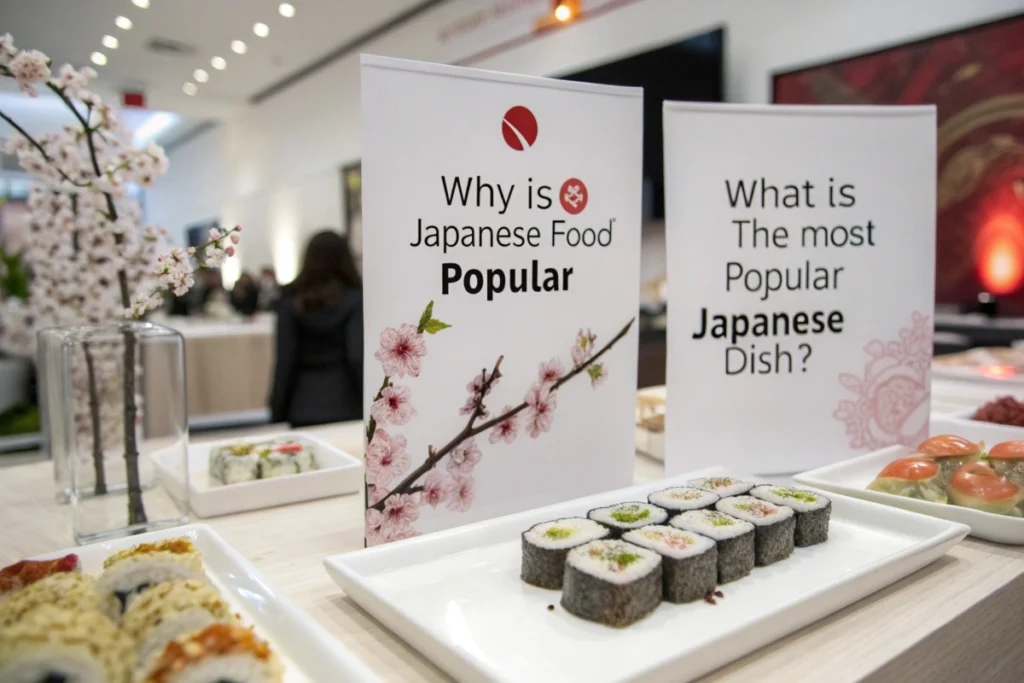
Conclusion
The popularity of japanese food is a testament to its rich cultural heritage, innovative spirit, and universal appeal. From the meticulous artistry of sushi and the comforting warmth of ramen to the visually stunning presentations of kaiseki, Japanese cuisine offers a diverse and satisfying culinary experience. Its emphasis on fresh ingredients, health benefits, and aesthetic beauty resonates with a global audience seeking both nourishment and delight.
As Japanese food continues to evolve, embracing both tradition and modern influences, its popularity shows no signs of diminishing. Japanese cuisine remains a beloved and influential force in the global culinary landscape. People enjoy it in high-end restaurants, bustling street markets, and the comfort of their own home kitchens.
For those eager to explore more traditional dishes, check out our japanese-steak-recipe for an authentic take on a classic favorite. Embracing Japanese food means not only savoring delicious flavors but also appreciating the cultural significance and dedication that go into each dish. As the world continues to embrace diverse culinary traditions, the enduring popularity of japanese food ensures that it will remain a cherished and influential cuisine for generations to come.
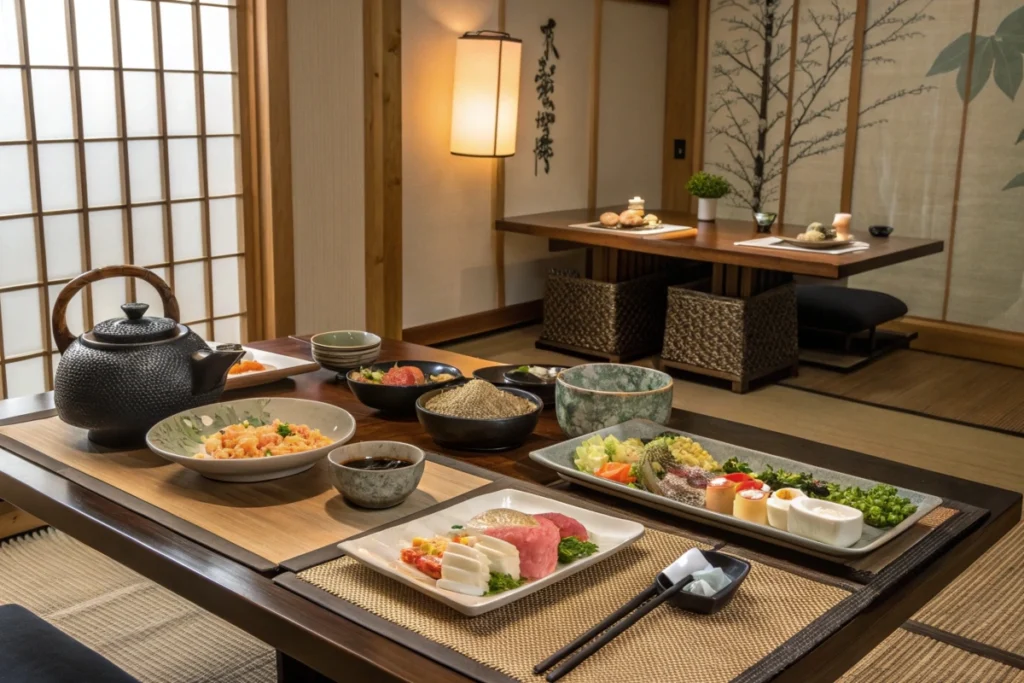
Essential Pantry Ingredients in the Japanese Kitchen
